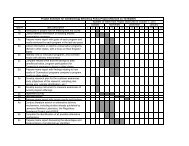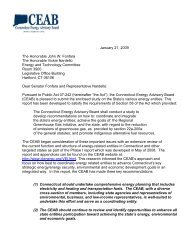Algonquin Power Windsor Locks Windsor Locks, CT
Algonquin Power Windsor Locks Windsor Locks, CT
Algonquin Power Windsor Locks Windsor Locks, CT
Create successful ePaper yourself
Turn your PDF publications into a flip-book with our unique Google optimized e-Paper software.
<strong>Algonquin</strong> <strong>Power</strong> <strong>Windsor</strong><br />
<strong>Locks</strong><br />
<strong>Windsor</strong> <strong>Locks</strong>, <strong>CT</strong>
History of the Facility<br />
• Commissioned April 14, 1990, as Dexter<br />
Cogeneration Facility<br />
• PPA with CL&P for 38-39 39 MW for 20 yrs.<br />
• Supply electric and steam for adjacent<br />
Dexter/Ahlstrom Paper Mill<br />
• Mill electric demand is 8-138<br />
MW<br />
• Steam demand is 40-100<br />
Klbs/hr
History of the Facility<br />
• 2000 – Dexter Corporation liquidated/sold<br />
company to Ahlstrom Fiber Composites<br />
• 2003 – Ahlstrom sold the Cogen plant to<br />
<strong>Algonquin</strong> <strong>Power</strong> Income Trust of Canada<br />
• Presently known as <strong>Algonquin</strong> <strong>Power</strong> <strong>Windsor</strong><br />
<strong>Locks</strong>, LLC<br />
• Historical plant availability on-peak is >99%<br />
and off-peak ~ 94%
Benefits of the Facility<br />
• The design of a Gas Turbine combined cycle<br />
provides a more efficient use of our fuel (~ 50%<br />
Thermal eff. vs. ~ 35% conventional fossil<br />
plant)<br />
• The Ahlstrom mill benefits by having lower<br />
energy costs so that they can be more<br />
competitive in their markets<br />
• Societal benefits include the efficient use of our<br />
resources with the least environmental impact<br />
and minimal cost to <strong>CT</strong> ratepayers
Host Relationship<br />
• Plant owned by the host<br />
• Plant owned by a third party<br />
• Coordinating plant/mill outages,<br />
operating schedules, interfacing systems<br />
(water, waste streams, site<br />
environmental responsibilities)
End of PPA<br />
• The PPA with CL&P ends on April 13,<br />
2010<br />
• CL&P not interested in extending or<br />
renewing the PPA<br />
• CL&P no longer in the power business
Post PPA Operations<br />
• Being forced to enter the electric market<br />
introduces the complexity of having to<br />
meet a base load commitment (Mill) with<br />
a plant that now is dispatchable to the<br />
grid intermittently<br />
• Cost impact to both Mill and APWL<br />
• Will run the plant dramatically less<br />
efficient to satisfy the above scenario
Effects of Deregulated<br />
policies on DG incentives<br />
• Without a PPA with the utility, an existing<br />
PURPA unit such as APWL is forced to<br />
alter its operations to adapt to market<br />
rules which can run counter to operating<br />
efficiently and reliably and can negatively<br />
impact the host.<br />
• Complexities include: fuel purchasing,<br />
power prices, market compliance<br />
management w/ a limited staff on-site
Effects of Deregulated<br />
policies on DG incentives<br />
• As a third party operator, dramatically<br />
increases the business risk to both parties<br />
• The mill (host) and the Cogen, , both rely on<br />
each other to exist in business<br />
• With the utility being indifferent to maintaining a<br />
relationship with a concept that was developed<br />
by PURPA, places at risk the two companies<br />
future and the negative economic impact it will<br />
create to the local economy & the state
Thank you for your attention<br />
Question






